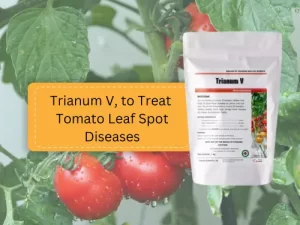Have you often spotted different types of marks on tomato leaves or stems, well if you have, beware it is a leaf spot tomato diseases. Now is the time to analyze what these are and find how to control septoria leaf spot?
Tomato leaf spot diseases refer to infections in tomato plants that manifest as spots on leaves, leading to premature leaf drop, reduced yield, and compromised plant health.
Scroll down to know more about the type of disease and its cure.
The initial symptoms appear as small, circular spots on tomato leaves, typically with dark brown edges and lighter centers. These spots can proliferate and may reach such a level resulting in leaf yellowing and early premature leaf shedding. As more leaves drop, the plant’s ability to photosynthesize is reduced, impacting fruit development and yield.

Tomato Early Blight
The fungus Alternaria solani is responsible for having tomato early blight. Most often, the areas of destruction on the leaves are large and brown with multiple rings around them, giving a “target” appearance to the leaves. This characteristic is why early blight presents a typical pattern, helping to distinguish it from other tomato diseases. The presence of concentric rings and specific spots on the leaves often indicate early blight, setting it apart from other common tomato plant diseases.
Fungi spores not only develop on the leaves but can also appear on the stems and fruits. This can lead to serious fruit rot, especially when the disease is left uncontrolled. If the disease progresses without intervention, it can significantly affect the health of the plants and their yield. The disease takes toll as it proceeds, leading to defoliation and subsequently making the fruits prone to sunscald and other secondary infections. This addition contact may lead to even more deterioration of products which results in (yield it off) which is less.
Warm and humid weather conditions typically characterize this disease, often spreading through direct contact, wind, and rain. Contaminated gardening tools can also contribute to its spread. Mold usually resides in dead plant matter, like leaves and stems from the previous growing season. If not entirely removed, this dead plant matter can become a reservoir for infection in the next growing season.
Preventive tomato early blight treatments include:
Early Blight fungicide measures such as Cropium is sometimes used to handle the early blight but is more effective in the worst cases. Early blight organic treatment like organic substances: copper-based fungicides and other organic products are able to trigger proper outcomes when early application and consistent sprays through the growing season are effectuated.

Bacterial speck tomato leaves, a disease which is infected by the bacterium Pseudomonas syringae pv. Angular Leaf Spot is a bacterial disease in tomatoes that causes tiny black marks with a yellow halo on leaves, stems, and fruit. When these spots affect plant development, the plants often become less healthy, and fruit production decreases. These spots are especially damaging during active periods, causing significant fruit destruction, ultimately leading to lower yields and reduced market value for tomatoes.
Reason of Bacterial Speck of tomato
Bacterial speck tomato treatment
Adopt practices that reduce bacterial speck on tomato plants to increase your chances of achieving a healthy and bountiful harvest.

Bacterial Leaf Spot in Tomato
It is caused by different strains of Xanthomonas campestrisplant pathogen. It will result in spots and blotchy patches on leaves, fruits, and stems of tomato plants, negatively affecting the quality of crop and their market value. The thickened spots on leaves may cause early defoliation and therefore reduce the plant’s photosynthesis and the overall production of fruits. The appearance of the spots on the fruit causes the decrease in its resale value, thus the market yields become devalued during growing season for gardeners and farmers.
Bacterial spot of tomato symptoms:
Bacterial leaf spot treatment:
Adopting these practices can prevent Bacterial Leaf Spot, allowing us to protect our tomato crop from damage and loss.
The first step is to observe the symptoms and identify the disease. Check for the contaminated plants and ensure to remove them before they spread the disease to the remaining plants.
Although removing the source would lower the risk of spread of disease, it is equally important to use the clean gardening tools and equipment to avoid the cross contamination.
One of the major reasons for most of the above diseases is the warmth and humidity which indeed helps in the growth of the fungi and bacteria. Providing plants with adequate space and enhanced air circulation will help in deterring the growth of disease causing bacteria and fungi.
Also segregating the potentially contaminated soil from the plants will help them to remain healthy.
Always having and growing a similar crop can make the soil more prone to diseases. To avoid this use the crop rotation practice with non-solanaceous crops to reduce disease pressure from soil pathogens. When selecting tomato varieties to grow, choose those resistant to specific leaf spot diseases to minimize the risk of infection and reduce the chance of disease-related issues in your tomato plants.

Trianum V to treat Leaf Spot Diseases.
Precaution has always been better than cure, likewise for plants and their diseases. Use of biological control agents for diseases can provide two fold benefits. Firstly, protecting the plants from diseases, secondly doing this while protecting the soil. The use of septoria leaf spot fungicide, Trianum-V, either as foliar spray or directly applying it to the roots of the plants can give plants another opportunity to grow and flourish by reducing the risk of soil-borne pathogens and other disease-causing fungi.
This septoria leaf spot fungicide, which contains is non toxic and easily compatible with other management practices. The use of Trichoderma harzianum not only improves the nutrient intake capacity of the plant but also induces systemic resistance.
Did you also see the green, brown, or gray..
Tomato root rot is one of the major obstacles..
Food plants often get dumped by various pests and..

Leave a Reply